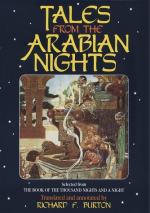first “killed” the damsel by touching
her head with the golden stick. The return of
the seven hundred rakshasas was like the noise of
a mighty tempest. One of them entered the damsel’s
room and revived her, saying at the same time, “I
smell a human being!"[FN#441] The damsel replied,
“How can a human being come to this place?”
and the rakshasa was satisfied. During the night
the damsel worms out of the rakshasi who was her mistress
the secret that the lives of the seven hundred rakshasas
depended on the lives of a male and female bee, which
were in a wooden box at the bottom of a tank, and
that the only person who could seize and kill those
bees was a youth with a moon on his forehead and stars
on the palms of his hands—but there could
be no such youth, and so their lives were safe.[FN#442]
When the rakshasas had all gone out as usual next morning,
the damsel, having been revived by the youth, told
him how the demons could be killed, and, to be brief,
he was not slow to put her directions into practice.
After the death of the seven hundred rakshasas, the
youth took some of the kataki flowers and left the
palace accompanied by the beautiful damsel, whose
name was Pushpavati. They passed through the ocean
and forest of kachiri in safety, and arriving at the
house in the bazar the youth with the moon on his
forehead presented the kataki flower to his sister.
Going out to hunt the next day, he met the king, and
his turban again falling off as he shot an arrow,
the King saw the moon on his forehead and desired his
friendship. The youth invited the King to his
house, and he went thither at midday. Pushpavati
then told the King (for she knew the whole story from
first to last) how his seventh wife had been induced
by his six other wives to ring the bell twice needlessly;
how she gave birth to a boy and a girl, and pups were
substituted for them, how the twins were miraculously
saved and brought up in the house of a potter, and
so forth. When she had concluded the King was
highly enraged, and next day caused his six wicked
wives to be buried alive. The seventh queen was
brought from the market-place and reinstated in the
palace, and the youth with a moon on his forehead
and stars on the palms of his hands lived happily
with his beautiful twin-sister.
In two other Hindu versions known to me—but
the story is doubtless as widely spread over India
as we have seen it to be over Europe—only
the leading idea of Galland’s tale reappears,
though one of them suggests the romance of “Helyas,
the Knight of the Swan,” namely, the story called
“Truth’s Triumph,” in Miss Frere’s
“Old Deccan Days,” p. 55 ff. Here
a raja and his minister walking together come to a
large garden, where is a bringal- tree bearing 100
fruits but having no leaves, and the minister says
to the raja that whosoever should marry the gardener’s
daughter should have by her 100 boys and one girl.
The raja espoused the maiden, much to the vexation
of the 12 wives he had already, and then follows a




